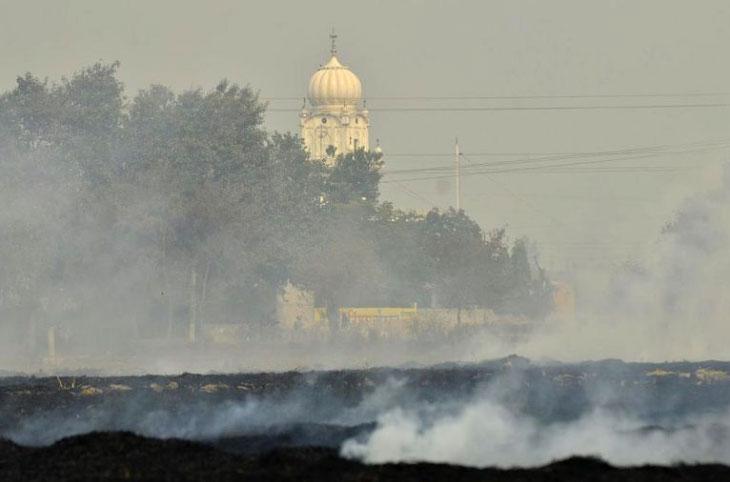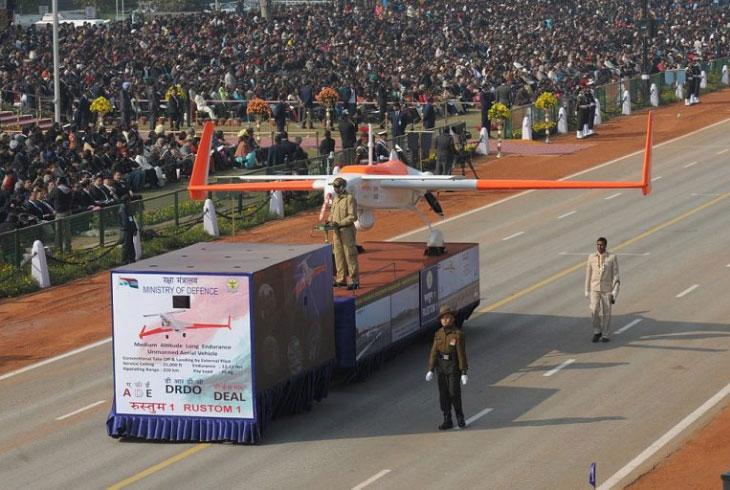NITI Aayog’s action plan for air pollution: Old wine in a new bottle?

- India’s national think tank, NITI Aayog, has suggested a 15-point action plan to tackle air pollution. It emphasises using electric vehicles and suggests other measures like strict curbs on vehicular emissions and an integrated waste management policy.
- The NITI Aayog plan is the latest in a series of plans recommended by different agencies for tackling air pollution, especially in Delhi and adjoining regions, reported to have some of the most polluted cities in the world.
- As many of the existing plans await implementation, environmentalists say the key to tackling air pollution menace is not the number of plans but proper implementation and monitoring of the measures suggested.
In yet another addition to the list of plans drawn out to tackle toxic levels of air pollution in India’s national capital and other major cities, the central government’s think tank, NITI Aayog, has now suggested a 15-point action plan to manage air pollution.
But is this just ‘old wine in a new bottle’?
Earlier this month, NITI Aayog unveiled a booklet “Breathe India – An Action Plan for Combatting Air Pollution”, which includes a list of 15 action points across a range of industries and sectors. The plan calls for “concerted action from all levels of governance, cutting across ministries and departments” and covers “all stakeholders without whose active participation and support the air pollution crisis cannot be tackled.”
“While a majority of these action points present immediate tasks that should be undertaken by the concerned authorities, they also include activities that are more long-term in nature. In addition, several action points begin with specific interventions that need to be undertaken by the most polluted cities in the country. Such a comprehensive approach will allow for more sustainable solutions in fighting air pollution,” the plan noted.
This is not the first time a comprehensive plan for tackling air pollution is suggested. In the past few years, the Supreme Court of India and the National Green Tribunal has heard several cases connected to high air pollution in the country, mainly Delhi-NCR and adjoining areas. As a result of those cases and sustained public pressure, several plans have been prepared by different authorities.

For instance, a Graded Response Action Plan was formulated in December 2016 for Delhi-NCR area following a case in the Supreme Court. In December 2017, a task force led by Nripendra Misra, Principal Secretary to the Prime Minister of India, also released a 12-point draft plan to tackle pollution in the Delhi-NCR region.
Most recently, in April 2018, the union Ministry of Environment, Forest and Climate Change (MoEFCC) unveiled a National Clean Air Programme (NCAP) – a first such plan to address the issue at the national level. The NCAP is yet to be finalised but it was criticised as experts felt that the plan lacks clear pollution reduction targets and city-wise or region-wise milestones, relies heavily on the state governments and lacks the teeth to ensure compliance.
So does this NITI Aayog action plan simply add to the list of documents presented by various authorities? Experts said that the plan reiterates arguments made in other such documents and tackling air pollution is only possible with implementation and monitoring of the recommendations in the plan.
What’s new about the NITI Aayog plan?
Some of the major steps suggested in the plan are large-scale adoption of electric vehicles, phasing out of diesel vehicles by 2022 from the top ten polluted cities of the country, enacting strong measures to curb vehicular emissions, reducing emissions in the power sector by measures like decommissioning of old and inefficient power plants, implementing a national emissions trading system, adopting cleaner construction practices, implementing a business model to utilise crop residue and an integrated waste management policy, tackling city dust, making efforts to tackle forest fires, adopting clean cooking practices and improving air quality monitoring systems.
With a significant focus on the usage of electric and hybrid vehicles, the plan said the procurement of electric vehicles (EVs) should be mandatory for vehicles for central government use and all central government offices should replace existing fleets older than 15 years with electric vehicles in the next three years, by April 2021.

It also called for setting up of low-emission zones in Delhi and other similar cities by restricting private vehicle entry in highly polluted zones, supported by clean public transportation, preferably based on electric vehicles.
The NITI Aayog plan mirrors the 12-point draft plan for Delhi-NCR, which had also stressed on adopting electric vehicles. It had called for “policy support to encourage electric vehicles, prioritising the use of EVs for public transport and promoting shared and connected mobility”. In 2017, the government of India had announced a mass scale transition to electric vehicles by 2030.
Lack of much-needed monitoring stations
The NITI Aayog action plan identifies a serious lack of real-time air quality monitoring stations. It highlighted that “India has 39 on-ground real-time air pollution monitoring systems spread across 23 cities as compared to China, which has 1,500 of such systems spread in over 900 cities.”
“To enable interventions to combat air pollution, the numbers of such systems needs to be much higher. It can be accomplished by using the data captured via geostationary satellites – like the Sentinel 5-P launched by European Space Agency in 2017. The advanced high resolution Tropospheric measuring instruments atop such satellites can measure wide range of pollutants in air. Additionally, these advanced instruments will aid the understanding of how the pollutants spread in the atmosphere, major sources of pollutants and accumulation hotspots,” said the action plan.
It even suggested exploring the “usage of drones and UAVs (Unmanned Aerial Vehicles)” for capturing air quality.
The MoEFCC’s NCAP had also emphasised increasing the number of air quality monitoring stations across the country, including in the rural areas.
Similarly, both the NITI Aayog’s plan and MoEFCC’s NCAP emphasise the importance of tackling city dust as the high content of particulate matter and pollen in the dust affects health and visibility.
Forest fires and ‘feebates’
But the NITI Aayog’s action plan also focuses on areas which do not find a mention in other plans. For instance, it calls for a “comprehensive national policy for prevention and control of forest fires” urgently.
Additionally, the NITI Aayog’s plan suggested the implementation of a large-scale ‘feebate program’ from 2020 under which inefficient or polluting vehicles incur a fee while efficient ones receive a rebate. Countries like Austria, Denmark, France, Netherlands, Norway, Canada (Ontario) and Singapore have introduced variations of ‘feebates’.
The plan recommended that a congestion pricing scheme could be employed in big cities like Delhi to discourage private vehicle use. “High congestion stretches in all major stretches for all major cities should be immediately identified and a congestion tax/charge should be imposed immediately,” it said.
It further calls for preparing an ‘Environment Risk Assessment’ for any cluster where large scale construction is going to take place.
The action plan recommends pilot projects involving new and upcoming technologies like blockchain to be integrated with broader policy on waste management. Giving international and domestic examples, it suggested that there are initiatives “demonstrating the use of blockchain in waste management. For example, in return for items recycled, tokens are provided to people that can be exchanged for other services.”
The world’s most polluted cities
In the past few years, air pollution has become a topic of national discussions after hazardous levels of air pollution were recorded from many Indian cities. In May 2018, a report by the World Health Organisation revealed that India has 14 out of the world’s 15 most polluted cities in terms of the levels of particulate matter, especially PM2.5. It was similar to WHO’s report in 2014 and 2016, which also noted that some of the most of the world’s top polluted cities were in India.

The 2018 report noted that Kanpur, Faridabad, Gaya, Varanasi and Patna are the top five most polluted cities in the world. Accordingly, the NITI Aayog plan gives a special thrust to reducing pollution across 10 most polluted cities in India (in terms of PM2.5 concentrations) over the course of next few years.
However, this focus on battling pollution in certain cities is not convincing for some environmentalists. “Overall, the NITI Aayog plan is a good step but why is the thrust limited to certain cities,” said environmentalist Vikrant Tongad, who is fighting a case in the National Green Tribunal regarding air pollution due to crop burning in northern India.
“It is also not foolproof because it was prepared without proper public consultation. It also seems that the plan is prepared without consulting other government authorities like the Central Pollution Control Board and transport ministry,” he said.
The WHO report had also noted that air pollution has emerged as a serious threat to life, causing almost seven million deaths a year.
According to the State of Global Air 2017 Report, the heavy load of particulate matter – especially PM2.5 – makes northern India amongst the second worst regions in the world.
“In 2015, long-term exposures to ambient PM2.5 contributed to 4.2 million deaths and a loss of 103 million years of healthy life (disability-adjusted life years or DALYs), making PM2.5 exposure responsible for 7.6% of all global deaths and 4.2% of all global DALYs. China and India each had the highest absolute numbers of deaths attributable to PM2.5. Together, these two countries accounted for 52% of the total global PM2.5-attributable deaths and 50% of the DALYs,” said the report.
[Read Mongabay-India’s piece on the disease burden of Delhi’s smog here.]
For a developing country like India, which has hundreds of millions under poverty, pollution and its health effects is fast becoming a public health concern.
Multiple plans to control air pollution
With air pollution in India becoming an international issue, several reports and action plans on combatting air pollution exist, including a first-of-its kind National Clean Air Programme released this year by India’s environment ministry.
But in the absence of implementation, environmentalists remain sceptical when action plans like the NITI Aayog one are released.
“Everyone is coming out with its own plan for tackling pollution. It would have been much better if everyone works in coordination,” environmentalist Tongad added.
Agra-based paediatric surgeon Dr. Sanjay Kulshreshtha, who has been fighting cases in the NGT and the SC seeking implementation of strict anti-pollution measures, said, “I believe most of the plans to tackle pollution in India are just on paper. There is a huge reluctance on the part of the government to act on issues that require urgent attention. All the authorities are shying away from the action on the ground. For instance, vehicular pollution is a huge source of air pollution and we need to address the number of vehicles, especially personal cars, in addition to purification of diesel and petrol but authorities have been dragging their feet to take action in controlling the number of vehicles.”
He added, “We just can’t solve the problem of air pollution (and traffic jams that closely linked to pollution) unless in addition to present measures, simultaneously we address the number of personal cars in the city, no matter how much money we pump. Measures like the number of flyovers, widening of roads and purification of fuels would be neutralised or fail if we don’t control the number of personal vehicles.”.
On NITI Aayog’s action plan, a senior official of the MoEFCC said that they will soon finalise NCAP. “We are giving a final shape to the NCAP and we will try to include as much as possible from the NITI Aayog’s plan,” said the MoEFCC official.
Need for greater focus on compliance of plans
With the abundance of laws in India, including many around combatting air pollution, environmentalists are hoping for a greater focus on implementation now.
“For any action plan in process, whether the NITI Aayog, environment ministry or state governments, the bigger issue that all of them will need to address is setting up of time-bound targets for pollution reduction and more importantly to come out with a clear compliance and deterrent strategies,” said Anumita Roychowdhury, of the Centre for Science and Environment (CSE), a Delhi-based environment thinktank.
She pointed out that unless that is done no plan will ever work.
“No plan will ever work effectively if you have not given a clear compliance and monitoring process. You may have an ambitious list of what needs to be done. But if there is no system of monitoring its time-bound implementation and accountability for enforcement than the plans are not going to work,” she added.
This article was first published in Mongabay.
First published: 24 July 2018, 17:24 IST
